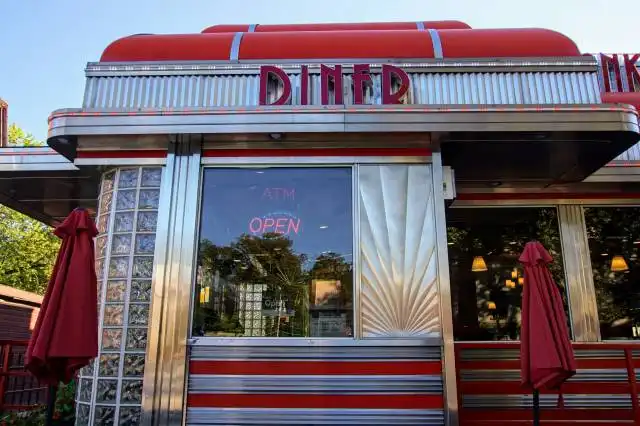Start a Sub Shop
Submerge into the Sandwich Dream: Starting Your Own Sub Shop
| Updated


SUB SHOP
Embarking on a submarine sandwich shop venture is like diving deep into an ocean of culinary delights! This business idea is your chance to put your personal stamp on every hoagie, grinder, or hero that comes out of the kitchen. A sub shop caters to meat lovers, vegetarians, and everyone in between, offering customizable, fresh-baked rolls packed full of delectable fillings. So, toss that apron on, tune into your customers' sandwich dreams, and turn them into the sub of the day!
Jump to Business Plan
RELATED BUSINESS IDEAS
Browse ALL Food & Beverage Entrepreneurship Business Ideas
Discover Your Perfect Domain
Unlock the door to your online success with our hand-picked selection of premium domain names. Whether you're starting a new venture or rebranding an existing one, the right domain can set the tone for your digital presence. Browse through our curated list, each with its unique potential to enhance your brand's visibility and credibility.
SUB SHOP MINI BUSINESS PLAN
This a quick reality check to help you identify the strengths and weaknesses of your business concept before you dive in.
Expected Percent Margins:
- Gross Margin: 60-70%
- Net Profit Margin: 10-15%
Expected Earnings:
- Daily Earnings: Approximately $600 - $1,200
- Weekly Earnings: Approximately $4,200 - $8,400
- Monthly Earnings: Approximately $18,000 - $36,000
- Annual Earnings: Approximately $216,000 - $432,000
Actions to Achieve Those Numbers:
Supply and Inventory Management:
- Initial Purchasing Costs: Dedicate a budget around $10,000 for initial ingredient purchasing.
- Maintain Food Stock: Make sure that Fresh ingredients are always available.
Marketing:
- Online Visibility: Invest in a professional, easy-to-use website.
- Social Media Engagement: Regular updates on social meals and special discounts.
- Local Advertising: Budget at least $500 per month for advertisements.
Sales and Operations:
- Efficient Ordering System: Streamline the order and checkout process to increase customer throughput.
- Extended Hours: Consider opening early for breakfast and/or staying open late to increase revenue.
Staffing:
- Hiring: Start with 3-5 employees.
- Training: Ensure all staff is well-trained to maintain food quality and provide superior customer service.
Location:
- Choosing Location: A high-traffic area such as a busy shopping plaza, downtown area, or near a university.
These estimates are quite general, your location, brand, and operational efficiency can significantly influence these numbers, It's advised to consult with a business financial advisor for personalized planning.
NOT WHAT YOU HAD IN MIND? Here are more ideas



Browse ALL Food & Beverage Entrepreneurship Business Ideas
Grab Your Business Website Name
Before you get caught up in the whirlwind of setting up your business, invest in a domain name. It's a small but significant step that lays the foundation for your brand and makes it easier for customers to find and trust you. Just like you wouldn't build a house without securing the land first, don't build a business without securing your domain name.
"Why? Can't that wait?" Here's why it shouldn't
Step 1: Determine if Starting a Sub Shop is Right for You
Breakdown of Startup Expenses
Before starting a sub shop, it is important to understand the startup expenses associated with the business. This includes the cost of the building, equipment, supplies, and any other necessary items to get the business up and running. Additionally, you should factor in the cost of any licenses or permits required by the local government. It is also important to consider the cost of hiring and training employees, as well as any marketing costs.
Breakdown of Ongoing Expenses
Once the business is up and running, there are several ongoing expenses to consider. These include the cost of ingredients, rent, utilities, insurance, and any other necessary supplies. Additionally, you should factor in the cost of payroll, employee benefits, and any other costs associated with running the business.
Examples of Ways to Make Money
There are several ways to make money with a sub shop. The most obvious way is to sell subs, but you can also offer catering services, delivery services, and other food items. Additionally, you can offer discounts and promotions to attract new customers. You can also partner with local businesses to offer discounts and promotions to their customers. Finally, you can offer online ordering and delivery services to reach a wider customer base.
Step 2: Name the Business
When naming a business, it is important to consider the type of business, the target audience, and the goals of the business. It is also important to consider the potential for growth and the ability to trademark the name. It is also important to consider the potential for the name to be memorable and to stand out from the competition. Additionally, it is important to consider the potential for the name to be used in marketing and advertising. It is also important to consider the potential for the name to be used in a domain name and social media accounts. Finally, it is important to consider the potential for the name to be used in a logo.
Step 3: Secure Financing
Securing financing for a business venture is a crucial step in the process of starting a sub shop. There are a variety of sources of financing available, such as personal savings, loans from family and friends, bank loans, and venture capital. Depending on the size of the business and the amount of capital needed, one or more of these sources of financing may be a viable option.
Business Plan
Creating a business plan is essential for securing financing. A business plan should include a detailed description of the business, a market analysis, a financial plan, and a marketing plan. It should also include a breakdown of startup costs, ongoing expenses, and potential sources of revenue. A well-crafted business plan will help convince potential lenders that the business is a sound investment.
Applying for Loans
Once a business plan is complete, the next step is to apply for loans. This involves submitting the business plan to potential lenders and providing any additional documentation that may be required. It is important to be prepared to answer questions about the business and to be able to explain why the business is a good investment.
Other Considerations
When applying for a loan, it is important to consider the terms of the loan. This includes the interest rate, the repayment schedule, and any other fees or charges that may be associated with the loan. It is also important to consider the impact of the loan on the business’s cash flow and the overall financial health of the business.
Step 4: Find the Right Location
When selecting a location for a sub shop, there are several factors to consider. First, the location should be in an area that has a large number of potential customers. This could be a busy street corner, a shopping center, or a college campus. Second, the location should have enough space to accommodate the necessary equipment and seating. Third, the location should have access to utilities such as water and electricity. Finally, the location should have adequate parking for customers.
Research Local Regulations
Once a potential location has been identified, it is important to research local regulations. This includes zoning laws, health codes, and other regulations that may affect the operation of the business. It is also important to research any permits or licenses that may be required to operate a sub shop in the chosen location.
Negotiate a Lease
Once the research is complete, it is time to negotiate a lease with the landlord. This should include the terms of the lease, such as the length of the lease, the amount of rent, and any other conditions that must be met. It is important to negotiate a lease that is fair and beneficial to both parties.
Secure Financing
Once the lease is signed, it is time to secure financing for the business. This could include a loan from a bank, a loan from family or friends, or an investment from a venture capitalist. It is important to have a clear plan for how the money will be used and how the business will be able to repay the loan.
Finalize the Business Plan
Once the financing is secured, it is time to finalize the business plan. This should include a detailed breakdown of the startup costs, ongoing expenses, and potential revenue streams. It should also include a timeline for when the business will be operational and a plan for marketing the business. This plan will be used to guide the business and ensure that it is successful.
Step 5: Create a Business Plan
Creating a business plan is essential for any business, and a sub shop is no exception. A business plan should include a description of the business, a market analysis, a description of the products and services offered, a description of the target market, a description of the competition, a marketing plan, a financial plan, and an operational plan.
Writing a Business Plan
Writing a business plan can be a daunting task, but there are many resources available to help. The Small Business Administration (SBA) is a great place to start. They offer free templates and resources to help entrepreneurs create a comprehensive business plan. Additionally, there are many online resources that offer step-by-step instructions on how to write a business plan. Once the business plan is written, it should be reviewed by a professional to ensure that it is accurate and complete.
Financing the Business
Once the business plan is complete, the next step is to secure financing for the business. This can be done through traditional lenders such as banks or through alternative financing options such as crowdfunding or angel investors. It is important to research all financing options to determine which is the best fit for the business. Additionally, it is important to understand the terms of any loan or investment and to ensure that the business can meet the terms of the agreement.
Registering the Business
Once the financing is secured, the business must be registered with the state and local government. This includes obtaining any necessary licenses and permits. Additionally, the business must be registered with the IRS and any other relevant government agencies. This process can be complicated and time consuming, so it is important to research the requirements and to ensure that all paperwork is filed correctly.
Step 6: Obtain Licenses and Permits
Before opening a sub shop, it is important to obtain the necessary licenses and permits. Depending on the state and municipality, the types of licenses and permits required may vary. Generally, businesses will need to obtain a business license, a food service license, and a health permit. A business license allows the business to legally operate in the state, while a food service license allows the business to serve food to customers. A health permit is required to ensure that the business meets all health and safety regulations.
How to Obtain Licenses and Permits
In order to obtain the necessary licenses and permits, the business owner will need to contact the local government office. The local government office will provide information on the types of licenses and permits required, as well as the process for obtaining them. Depending on the state and municipality, the process may involve submitting an application and providing proof of insurance. The business owner may also need to pay a fee to obtain the licenses and permits.
Cost of Licenses and Permits
The cost of licenses and permits will vary depending on the state and municipality. Generally, the cost of a business license and a food service license will range from $50 to $200. The cost of a health permit will depend on the type of food being served and the size of the business. In some cases, the cost of a health permit can range from $50 to $500.
Benefits of Obtaining Licenses and Permits
Obtaining the necessary licenses and permits is important for any business, as it allows the business to legally operate and serve customers. It also helps to ensure that the business is meeting all health and safety regulations. Additionally, having the necessary licenses and permits can help to protect the business from any legal issues that may arise.
Step 7: Purchase Equipment and Supplies
When starting a sub shop, there are certain pieces of equipment and supplies that are necessary for the business to run smoothly. This includes an oven, a refrigerator, a slicer, a toaster, a cash register, and a variety of utensils. Additionally, you will need to purchase a variety of supplies such as bread, meats, cheeses, vegetables, condiments, and other ingredients. It is important to research the best prices and quality of each item to ensure that you are getting the most bang for your buck.
Where to Purchase Equipment and Supplies
When it comes to purchasing the necessary equipment and supplies for your sub shop, there are a variety of options. You can purchase the items from a local restaurant supply store, online, or from a wholesaler. Additionally, you may be able to find used equipment that is still in good condition. It is important to do your research and compare prices and quality before making your purchase.
Cost of Equipment and Supplies
The cost of equipment and supplies for a sub shop can vary greatly depending on the size of the shop and the quality of the items. Generally speaking, the cost of the equipment and supplies can range from a few hundred dollars to a few thousand dollars. It is important to factor in the cost of the equipment and supplies when budgeting for the business.
Financing Options
If you are unable to purchase the necessary equipment and supplies up front, there are a variety of financing options available. You can apply for a loan from a bank or other financial institution, or you can look into leasing the equipment. Additionally, you may be able to find a vendor who offers financing or payment plans. It is important to research the different financing options to find the best option for your business.
Step 8: Hire Employees
Hiring employees is a critical step in starting a sub shop. It is important to find employees that are reliable and trustworthy, as they will be the face of the business. When hiring, it is important to consider the type of employees that will best fit the business. For example, a sub shop may need employees who are friendly and outgoing, as they will be interacting with customers on a daily basis. Additionally, it is important to consider the skill set of the employee. For example, a sub shop may need employees who have experience in food preparation and customer service.
Training Employees
Once the right employees have been hired, it is important to provide them with the necessary training. This training should include a thorough overview of the business, including the menu, customer service policies, and safety procedures. Additionally, it is important to provide employees with the necessary skills to perform their job, such as food preparation and customer service. Finally, it is important to provide employees with ongoing training to ensure that they stay up to date on the latest industry trends and customer service techniques.
Step 9: Market the Business
The ninth and final step in starting a sub shop is to market the business. There are many ways to market a business, including online, print, radio, and television advertising. Additionally, word-of-mouth advertising is a great way to get people talking about the business. Social media is also a great way to reach potential customers. Creating a website and utilizing search engine optimization (SEO) techniques can help potential customers find the business. Additionally, offering discounts and promotions can help attract customers. Finally, participating in local events and sponsoring local teams can help spread the word about the business.
Tips for Effective Marketing
When it comes to marketing a business, it is important to have a plan. It is also important to have a budget for marketing. Additionally, it is important to know the target audience and tailor the marketing messages to them. It is also important to track the results of the marketing efforts to ensure that the money is being spent wisely. Finally, it is important to be consistent with the marketing messages and to keep the messages fresh and up-to-date.
EXPLORE MORE CATEGORIES
Browse ALL Business Idea Categories
TAKE THE NEXT STEPS










